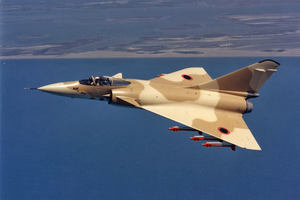NA107 Chainbreaker
This article is incomplete because it is pending further input from participants, or it is a work-in-progress by one author. Please comment on this article's talk page to share your input, comments and questions. Note: To contribute to this article, you may need to seek help from the author(s) of this page. |
| NA48 Chainbreaker | |
|---|---|

| |
| Role | Multirole/air superiority fighter |
| National origin | Talahara |
| Manufacturer | United Aeronautics Syndicate |
| First flight | 9 March 1998 |
| Introduction | 18 May 2004 |
| Status | In service |
| Primary user | Talaharan Air Corps |
| Produced | 1998–present |
| Number built | 182 |
| Program cost | $14 billion |
| Unit cost |
$70 million
|
| Developed from | NA28 Spirit Wind |
The NA48 Chainbreaker (Takelat: ⵏⴰ48 ⵔⴰⵣⴰⵜⵉⵙⵦⵏⵙⴰⵍⴰⵏ; NA48 Razatisensalan) is a twinjet, canard, delta-wing, multirole combat fighter. The Chainbreaker is generally regarded as a 4.5++ generation aircraft, equipped with advanced sensors and avionics with limited stealth design, and capable of engaging in supremacy, interdiction, reconnaissance, close air support, and anti-ship warfare missions.
Developed from the NA28 Spirit Wind, the Chainbreaker was intended to consolidate the roles of the NA28 Spirit Wind and the NA28/36 Sunray in a modern platform. The airframe first flew in 1998, but the development of the aircraft's systems delayed its official introduction to 2004. While primarily a domestic project, the full avionics and sensor suite was developed with a number of foreign resources and technologies.
Following its introduction, the Chainbreaker was marketed for export to a limited number of socialist republics worldwide. The Talaharan Air Corps remains the primary user of the aircraft, in addition to the Tyreseian Workers' Naval Air Service.